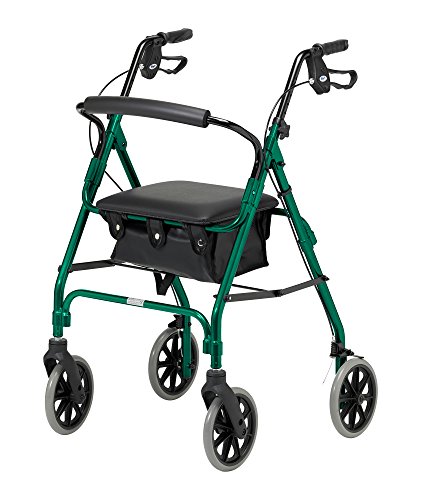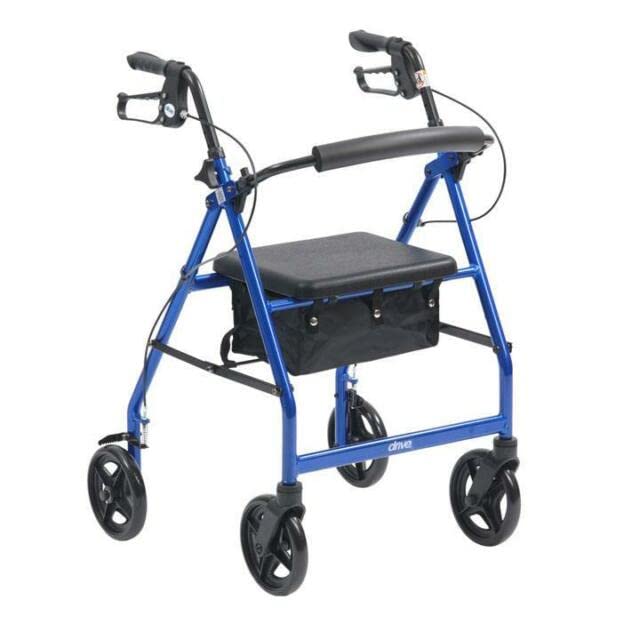How Rollator Mobility Walker Arose To Be The Top Trend In Social Media
페이지 정보

본문
 Rollator Mobility Walker
Rollator Mobility Walkerrollators uk are a great option for people with limited mobility and require stability while walking. They have large wheels and space for seats that are built into their frames.
The model comes with padding on the handles to offer comfort and ease pressure on the hands. It comes with height-adjustable handles as well as clever loop locks that stop the walker from moving when you're sitting or lying down.
Comfort
A rollator mobility walker is a great option for anyone who has had an injury that affects balance and gait, or is recovering from knee or hip surgery or any other lower-limb injury or surgery. These walking aids provide stability and support and allow users to walk more comfortably and remain active with family, friends and the community.
These devices are available in a variety of styles, such as the traditional walker with wheels that looks more plain than a rolling walker. Walkers have handles placed at the height that is most comfortable to the user. This makes them suitable for those who need solid support but wish to move forward more easily using the aid of a cane.
However the wheels on a rollator make it more flexible than a normal walker and more user-friendly. The wheels are located closer together, which means it is easier to move the device in tight spaces, and they can also be rotated for better agility when going up or down steps. Many folding rollators also have an armchair and a crossbar that provide a place for users to rest when they require.
The handles of a rollator can be constructed from materials that vary in texture and thickness. Grips made of plastic can be taxing for anyone with arthritic hands Choose soft and smooth handles that are comfortable to hold. Check if the device features loop-lock brakes or lean-activated brakes to accommodate various hand strengths.
Stability
A great rollator must have a comfortable and wide seat that people can sit on when they wish to take a break. It should also have soft ergonomic grips, brakes that are simple to operate. These grips should be cushioned and comfortable for those with hand or wrist issues. Some models come with a padded support backrest. You should choose an walker with an ability to carry a load sufficient for your needs and adjustable handles to fit your height.
A locking mechanism on a walker is crucial for those who frequently travel or have to carry the walker into and out of their vehicle. This will prevent the walker being accidentally opened during transit to avoid injury and damage. Another feature to consider is whether the walker is removable and interchangeable parts which allows you to customize it to suit your needs.
Researchers conducted a study to find out how the strategy for task-performance, and the device load affect rollator stability. The study involved ten participants who completed six tasks using an instrumented rollator. The researchers measured the combination centre of pressure and the base of support that is known as system Stability Margin (SM). They discovered that SM is reduced significantly when compared to straight line walking to other tasks. They also found out that leaning on the device may increase the centre of force in the support base and can also increase or decrease stability. The researchers conclude that their findings can be utilized to improve rollator training. They suggest that more emphasis should be placed on activities other than straight line walking and on the specific strategies to perform of each task that can aid or hinder stability.
Capacity for weight-bearing
A rollator walker is capable of supporting up to 300lbs, or more, depending on the model. Its sturdy frame and four wheels can help maintain balance and mobility for people, especially those with medical conditions or who are aging. As opposed to standard walkers which require lifting to move forward, a rollator is able to be operated using the user's weight, which can help reduce hand fatigue.
The wheels on a rollator generally range in size from 6 to 10 inches in diameter, providing users with the ability to work indoors and outdoor rollator use on various surfaces. Certain models have a variety of height options for different users. Others fold to make it easy to transport and store. Some even feature a seat to allow the user to rest while walking.
Many walkers come with a selection of accessories, like a walker basket that can hold personal items or an eating tray to put food on while using the device. Additional accessories include a wrist guard to shield hands from injuries, and bags for walker users to store more items. Some walker frames are compatible with wheelchairs, making it easy to convert when a person's mobility needs alter.
A bariatric roller is designed to help large people in a safe way. It is constructed with a sturdy frame and a wider seat. It has adjustable handles for height as well as a padded backrest that is wide and hand brakes that are locked to ensure the maximum security and safety. The angled handlebars put the hands in a relaxed, comfortable position. The strap for storage is convenient and allows it to be easily tucked to a trunk of a vehicle. The 8" wheels feature anti-tip technology that provides stability and maneuverability. The cushioned seat provides an ideal place to relax on the move.
Brakes
A rollator is a bit different from a typical walker. Rollators have wheels that can be controlled separately by hand brakes that are integrated or placed below the handlebars. This design helps to make it easier for users to navigate tight spaces and make sharp left or right turns. However, the brakes can sometimes become loose or hard to use, which could be a safety risk for those who have declining mobility and limited strength in their hands.
Many manufacturers provide the option of adding brakes that can be locked to increase security and stability. This feature is especially beneficial for individuals who may have difficulties squeezing or applying pressure to the brakes due to an insufficient grip or other health conditions like arthritis. There are some variations in the method by which locking brakes are set up, however most walkers use the same methods to ensure that they are set correctly.
It is important to read the maintenance instructions that come with your mobility device to get specific instructions before you attempt to adjust lock brakes. To begin, find the adjuster screw for your brake or knob which is usually located near the grips of the handle. Tighten it by rotating clockwise. This is crucial because if the adjuster isn't properly tightened, it will not be able to eliminate the brake cable from its slack. After tightening the screw for adjustment of the brake then move to the lower nut for the adjuster and tighten it with the same method. After you have finished these adjustments make sure you test your brakes by gently pressing the levers. If they do not then it is most likely that the locking mechanism is faulty.
Accessories
There are a number of accessories for the rollator walker. These include cup holders and baskets. Certain accessories are designed to carry items while walking, while others, like the Mobility Phone Grip clip onto the vertical bars on the walker or wheelchair, and expands to hold the smartphone. The grips can be adjusted to a suitable height to hold your phone. Many of these accessories are designed to be lightweight, simple to use, and ideal for those with arthritis.
Most manufacturers of walker and rollator provide a range of handle heights, so you can pick the one that is best for your body type. You should also take into consideration the capacity of a rollator's weight since this can affect the way it performs for you. Some manufacturers have bariatric models that can support up 500 pounds.
Another aspect to take into consideration when choosing a walker rollator is the kind of brakes it comes with. Push down brakes function by placing downward pressure on the frame to stop forward motion. Loop brakes are similarly designed, however they require the use of both hands and more physical strength to apply. Both types of brakes are an essential safety feature, so it's important to find the best 2 in 1 rollator transport chair (luna-roy-3.technetbloggers.de) choice for your needs.
 Talk to a doctor, physical therapist, or an occupational therapist if uncertain about which type of walker or rollercaster is the best choice for you. They can provide advice on the features that would be most beneficial for your specific situation, and can help you choose a model that's compatible with any equipment you may have at home or in storage.
Talk to a doctor, physical therapist, or an occupational therapist if uncertain about which type of walker or rollercaster is the best choice for you. They can provide advice on the features that would be most beneficial for your specific situation, and can help you choose a model that's compatible with any equipment you may have at home or in storage.- 이전글What Are Online Poker Sites? 24.09.03
- 다음글See What Composite Door Handle Replacement Tricks The Celebs Are Utilizing 24.09.03
댓글목록
등록된 댓글이 없습니다.